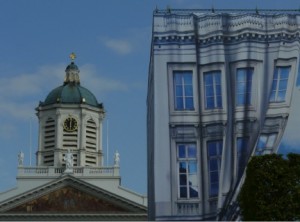Pulling back the curtain and starting a conversation
23 June 2014 – Mary Rizzo
methods, public engagement, profession, NCPH, The Public Historian, pulling back the curtain, NCPH Board Member Posts

Saint Jacques-sur-Coudenberg church and neighbor, Brussels, 2008. Photo credit: Eddy Van 3000
At this spring’s National Council on Public History annual meeting in Monterey, California, outgoing NCPH President Bob Weyeneth proposed that it was time for historians to let the rest of the world in on our trade secret about history: that it isn’t a static set of facts, but a matter of “interpretive fluidity” that demands a continual reassessment of what we know about the past. This way of understanding history is something that Weyeneth, like many of us fellow historians, took for granted until he was faced with public pushback and legal challenges when his work unsettled deeply held local narratives. Faced with the recognition that most people have no idea how historians approach learning about the past, Weyeneth came to think that it was time to “pull back the curtain” and be more transparent about what we do.
You can read the full text of Weyeneth’s presidential address here. Over the next few weeks, History@Work will present responses from public historians who reflect on the implications, opportunities, and dilemmas of letting the public in through the door usually reserved for the staff. What this series reveals is that the organization taking this approach is changed by the experience as much as—or more than—the public. As Allison Weiss describes in her upcoming piece, artists invited to use the collections of the Sandy Spring Museum as launching pads for their own creative work became magnets drawing visitors who were more interested in what the artists were doing with the collections than with the museum’s own static exhibits. While Sue Ferentinos and Benjamin Filene write about very different specific topics, they both suggest in their future posts that when museums allow for public commentary on object labels and exhibit content, they find that the public is more than ready to engage with interpretive fluidity and multiple perspectives on the past.
Look for the “pulling back the curtain” discussion to continue here on the blog over the coming months. These questions connect in obvious ways with a number of other ongoing efforts to communicate more clearly to our various publics what historians do as well as how and why they do it (for example, the History Relevance Campaign), but there’s also a connection with some plans that are in the works for the NCPH website, currently being redesigned.
One of the planned pieces of the renovated website is an online exhibit intended to help render historians’ work methods more understandable to those not trained in the discipline. Following Bob Weyeneth’s challenge, it will focus explicitly on the processes involved in historical interpretation and will present “revisionism” as an essential tool of historical knowledge-making rather than a dirty word. The exhibit will draw on work from around the public history field, which is where our readers come in. We’ll be inviting your suggestions for outstanding examples that will help us to illustrate public historians’ decision-making on matters relating to preservation, interpretation, and stewardship. We hope you’ll share your ideas when the time comes, as well as read Weyeneth’s essay and comment on the posts that follow.
~ Mary Rizzo is Co-Editor of The Public Historian and Public Historian in Residence at the Mid-Atlantic Regional Center for the Humanities at Rutgers University-Camden. She blogs at maryrizzo.net and tweets @rizzo_pubhist.
~ Cathy Stanton is Digital Media Editor for the National Council on Public History.




This conversation is absolutely necessary. I look forward to seeing where it goes, and contributing. We need more books that are “popular history” and show our process in an accessible way. My recent book A Grizzly in the Mail and Other Adventures in American History is an attempt to do just this. See the Public History Commons post at http://publichistorycommons.org/author/tim-grove/
Wow – that sounds incredible! I particularly like the effort to render historians’ work more legible to the public (and in doing so, perhaps more to ourselves as well!).
Anne Parsons
I love, love this conversation and this approach to history–partly because it reveals the contingencies in anything we understand about the past, but also partly because it lets people in on the fun of *doing* history. Mystery, detective work, frustration, dead ends, enlightening discoveries! Voyeuristically looking in at other people’s lives! Let’s face it: history is awesome, and we ought to stop presenting only the final, finished packages, which are just a part of the whole.